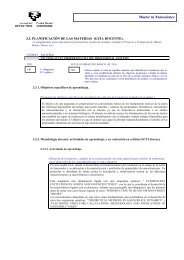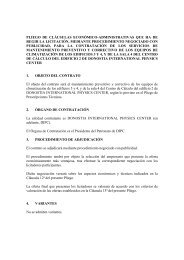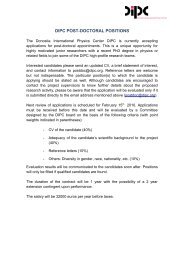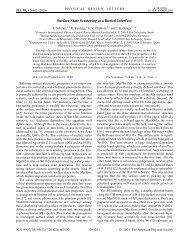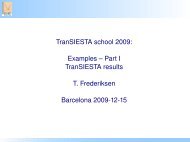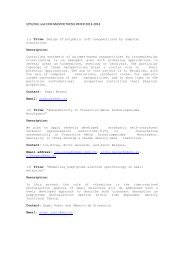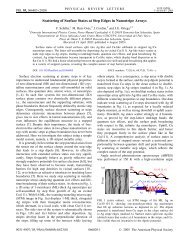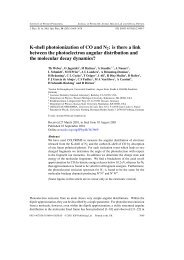V.M. Silkin et al. / Surface Science 601 (2007) 4546–4552 4551 point below. C e–e is plotted as a function of the cluster radius R. For small cluster sizes, the discretization of levels is clearly observable in the large oscillations found. For clusters of nanometer size, however, these oscillations are damped <strong>and</strong> the value of the linewidth is C e–e 150 meV. Let us also mention that an RPA calculation of the electron lifetime in a homogeneous electron gas, with the same parameters that we fix in our calculation (E 0 = 1 eV <strong>and</strong> r s = 4) gives a value C e–e = 60 meV [45], smaller than the ones obtained for these big clusters. One of the reasons not often discussed in the literature for the difference between the value of C e–e in bulk <strong>and</strong> in nanometer-sized clusters is the difference in the electron– electron screened interaction W(r,r 0 ,x) between an infinite electron gas <strong>and</strong> a finite jellium system, even for values of r <strong>and</strong> r 0 far from the cluster surface. In Fig. 7, we quantify this statement by showing the imaginary part of ImW(r,r 0 ,x) for a value of r nearby the cluster center (r = 0.31) <strong>and</strong> as a function of r 0 . The dimension of the chosen is sufficiently big (R = 38.8 a.u.) to consider that no surface effects are relevant. ImW is plotted for two different values of the energy, namely x = 0.815 meV <strong>and</strong> x = 54.4 eV. The former is representative of actual values of x that enter the calculation of C e–e in clusters. Fig. 7 shows that ImW(0, r 0 ,x = 0.815 eV) is clearly different in a cluster as compared to the bulk counterpart. The dynamic <strong>screening</strong> between electrons is thus modified due to the different mobility of electrons in a confined system. However, for higher values of x, the response of the system is similar to that calculated in the independentelectron approximation v 0 <strong>and</strong> finite-size effects are not relevant. Confinement effects are also relevant in the choice of the initial state in the decay process. The discretization of levels in the cluster makes it impossible to exactly define the same initial energy E 0 for all the cluster sizes considered. An estimate of the variation that this feature can introduce in the linewidth value is also shown in Fig. 6. For a cluster size of R = 31 a.u., the value of C e–e for two initial states very close in energy is plotted. One of them is the first l =13 state with E 0 = 1 eV, <strong>and</strong> the second one is a l = 4 state with E 0 = 0.99 eV. In spite of the proximity of the two energy levels, the value of C e–e varies as much as 35%. The main reason for that is the different coupling between the initial state wave function <strong>and</strong> the available final states for the decay. In Fig. 8, we show the normalized radial distribution of the KS wave functions rR l;E0 ðrÞ, where w 0 ðrÞ ¼R l;E0 ðrÞY lm ðX r Þ, for the two cases considered. The integrated radial distributions QðrÞ ¼ Z r 0 dr 0 r 02 R l;E0 ðr 0 2 Þ ð5Þ are plotted in Fig. 8 as well. While the l = 13 wave function does not have any nodes, oscillations in the l = 4 wave function are conspicuous. A proper definition of the initial excitation in the decay process can thus be crucial when calculating the linewidth. Fig. 7. Imaginary part of the self-energy ImW(r 0 ,r 0 ,x) (in eV) for a cluster of N = 912 <strong>and</strong> r s =4(R = 38.8 a.u.), as a function of the radial coordinate r 0 (in a.u.), for two different values of the energy x = 0.815 eV <strong>and</strong> 54.4 eV. The coordinate r 0 is fixed to 0.31 a.u. The corresponding values for ImW in an homogeneous electron gas obtained from Mermin response functions are also plotted for comparison. Fig. 8. Normalized radial distribution of wave functions with l =4, 13 <strong>and</strong> E 0 = 0.99, 1 eV, respectively, corresponding to a cluster with N = 440 <strong>and</strong> r s =4 (R = 30.42 a.u.). E 0 is measured from the Fermi level of the cluster. The integrated value of the wave functions is plotted in the upper panel.
4552 V.M. Silkin et al. / Surface Science 601 (2007) 4546–4552 4. Summary <strong>and</strong> conclusions Low-dimensional systems bear electronic properties that can be very different from those well studied in bulk systems. Here, we have shown that the modification of the dynamic <strong>screening</strong> in the electron–electron interaction <strong>and</strong> the change in the structure of energy levels in these systems can combine to drastically modify the linewidth of electronic excitations as compared to the bulk reference. In particular, we have analyzed the screened interaction between electrons <strong>and</strong> the phase space availability for the decay in two different cases: quantum well states in overlayers of Na over Cu(111) <strong>and</strong> gas-phase metal clusters of sizes up to few nanometers. In the former case, the amount of alkali atoms coverage on the metal surface leads to a shift of the QWS energy b<strong>and</strong>, that produces an appreciable change in the linewidth. In the latter case, the variation in size of the cluster is responsible for modifications in the decay rate. Our detailed analysis of these properties shows that a proper choice of the system characteristics should allow to tune the excitation linewidths due to electron–electron <strong>scattering</strong> processes. Acknowledgements Financial support by the Basque Departamento de Educación, Universidades e Investigación, the University of the Basque Country UPV/EHU (Grant No. 9/UPV 00206.215-13639/2001), the Spanish MEC (Grant No. FIS2004-06490-C03-00), <strong>and</strong> the EU Network of Excellence NANOQUANTA (Grant No. NMP4-CT-2004- 500198) is acknowledged. References [1] M. Aeschlimann, M. Bauer, S. Pawlik, W. Weber, S. Burgermeister, D. Oberli, H.C. Siegmann, Phys. Rev. Lett. 79 (1997) 5158. [2] H. Petek, S. Ogawa, Prog. Surf. Sci. 56 (1997) 239. [3] E. Knoesel, A. Hotzel, M. Wolf, Phys. Rev. B 57 (1998) 12812. [4] R. Knorren, K.H. Bennemann, R. Burgermeister, M. Aeschlimann, Phys. Rev. B 61 (2000) 9427. [5] E.V. Chulkov, A.G. Borisov, J.P. Gauyacq, D. Sánchez-Portal, V.M. Silkin, V.P. Zhukov, P.M. Echenique, Chem. Rev. 106 (2006) 4160. [6] U. Höfer, I.L. Shumay, Ch. Reuß, U. Thomann, W. Wallauer, T. Fauster, Science 277 (1997) 1480. [7] M. Weinelt, J. Phys.: Condens. Matter 14 (2002) R1099. [8] P.M. Echenique, R. Berndt, E.V. Chulkov, Th. Fauster, A. Goldmann, U. Höfer, Surf. Sci. Rep. 52 (2004) 219. [9] J. Kröger, L. Limot, H. Jensen, R. Berndt, S. Crampin, E. Pehlke, Prog. Surf. Sci. 80 (2005) 26. [10] J. Güdde, U. Höfer, Prog. Surf. Sci. 80 (2005) 49. [11] A.M. Bradshow, H.P. Bonzel, G. Ertl, Physics <strong>and</strong> Chemistry of Alkali Metal Adsorption, Elsevier, Amsterdam, 1989. [12] R.D. Diehl, R. McGrath, Surf. Sci. Rep. 23 (1996) 43. [13] We define one Na monolayer as the most densely packed structure of the first Na layer, namely a (3/2 · 3/2) unit mesh with 4 Na atoms per 9 Cu surface atoms: D. Tang, D. McIlroy, X. Shi, C. Su, D. Heskett, Surf. Sci. 255 (1991) L497; J. Kliewer, R. Berndt, Surf. Sci. 477 (2001) 250. [14] S.-Å. Lindgren, L. Walldén, Solid State Commun. 34 (1980) 671. [15] S.-Å. Lindgren, L. Walldén, Phys. Rev. Lett. 59 (1987) 3003. [16] N. Fischer, S. Schuppler, Th. Fauster, W. Steinmann, Surf. Sci. 314 (1994) 89. [17] E.V. Chulkov, J. Kliewer, R. Berndt, V.M. Silkin, B. Hellsing, S. Crampin, P.M. Echenique, Phys. Rev. B 68 (2003) 195422. [18] C. Corriol, V.M. Silkin, D. Sánches-Portal, A. Arnau, E.V. Chulkov, P.M. Echenique, T. von Hofe, J. Kliewer, J. Kröger, R. Berndt, Phys. Rev. Lett. 95 (2005) 176802. [19] C. Voisin, D. Christofilos, N. Del Fatti, F. Vallée, B. Prével, E. Cottancin, J. Lermé, M. Pellarin, M. Broyer, Phys. Rev. Lett. 85 (2000) 2200. [20] N. Pontius, G. Lüttgens, P.S. Bechthold, M. Neeb, W. Eberhardt, J. Chem. Phys. 115 (2001) 10479. [21] P. Gerhardt, M. Niemietz, Y. Dok Kim, G. Ganteför, Chem. Phys. Lett. 382 (2003) 454. [22] M. Drescher, M. Hentschel, R. Kienberger, M. Uiberacker, V. Yakovlev, A. Scrinzi, Th. Westerwalbesloh, U. Kleineberg, U. Heinzmann, F. Krausz, Nature 419 (2002) 803. [23] A. Baltus˘ka, Th. Udem, M. Uiberacker, M. Hentschel, E. Goulielmakis, Ch. Gohle, R. Holzwarth, V.S. Yakovlev, A. Scrinzi, T.W. Hänsch, F. Krausz, Nature 421 (2003) 611. [24] A. Borisov, D. Sánchez-Portal, R. Díez Muiño, P.M. Echenique, Chem. Phys. Lett. 387 (2004) 95. [25] L. Hedin, S. Lundqvist, Solid State Phys. 23 (1969) 1. [26] P.M. Echenique, J.M. Pitarke, E.V. Chulkov, A. Rubio, Chem. Phys. 251 (2000) 1. [27] M. Quijada, R. Díez Muiño, P.M. Echenique, Nanotechnology 16 (2005) S176. [28] J.M. Carlsson, B. Hellsing, Phys. Rev. B 61 (2000) 13973. [29] E.V. Chulkov, V.M. Silkin, P.M. Echenique, Surf. Sci. 437 (1999) 330. [30] J. Kliewer, R. Berndt, Phys. Rev. B 65 (2001) 035412. [31] L. Vitali, P. Wahl, M.A. Schneider, K. Kern, V.M. Silkin, E.V. Chulkov, P.M. Echenique, Surf. Sci. 523 (2003) L47. [32] M.G. Vergniory, J.M. Pitarke, S. Crampin, Phys. Rev. B 72 (2005) 193401. [33] V.M. Silkin, A. García-Lekue, J.M. Pitarke, E.V. Chulkov, E. Zaremba, P.M. Echenique, Europhys. Lett. 66 (2004) 260. [34] V.M. Silkin, J.M. Pitarke, E.V. Chulkov, P.M. Echenique, Phys. Rev. B 72 (2005) 115435. [35] M. Brack, Rev. Mod. Phys. 65 (1993) 677. [36] J.A. Alonso, L.C. Balbás, Topics in Current Chemistry, vol. 182, Springer-Verlag, Berlin/Heidelberg, 1996, p. 119. [37] W. Kohn, L.J. Sham, Phys. Rev. 140 (1965) A1133. [38] O. Gunnarsson, B.I. Lundqvist, Phys. Rev. B 13 (1976) 4274. [39] P. Fulde, Electron Correlations in Molecules <strong>and</strong> Solids, Springer- Verlag, Berlin, 1995 (Section 9.2.3). [40] W. Ekardt, Phys. Rev. B 31 (1985) 6360. [41] M.J. Puska, R.M. Nieminen, M. Manninen, Phys. Rev. B 31 (1985) 3486. [42] R. Díez Muiño, A. Arnau, A. Salin, P.M. Echenique, Phys. Rev. B 68 (2003) 041102(R). [43] J. Kliewer, R. Berndt, E.V. Chulkov, V.M. Silkin, P.M. Echenique, S. Crampin, Science 288 (2000) 1399. [44] P.M. Echenique, J. Osma, V.M. Silkin, E.V. Chulkov, J.M. Pitarke, Appl. Phys. A 71 (2000) 503. [45] J.M. Pitarke, Private Communication, 2004.



